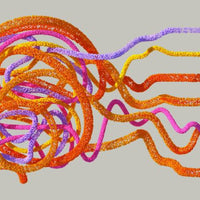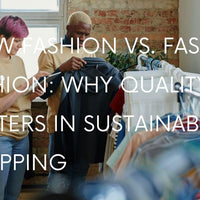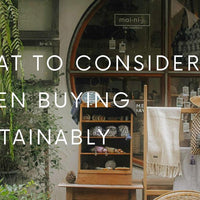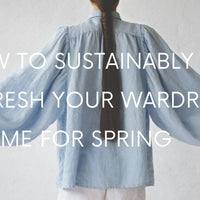Sustainable fashion is an important topic for many people these days. It's also something that we all need to think about when buying clothes. The good news is that there are lots of options available to us, and most of them are pretty easy to implement.
♡
Why is Sustainable Fashion Important?
Once upon a time, 170 thousand years ago, man first put on clothes. Early clothing would have been made from animal hides and that stayed on trend for the next 140-150 thousand years when weaving first began.
In the beginning, clothing had one practical purpose: Protection. However technological advances meant that clothing started to become much more than that. Clothing could be form-fitting, colorful, and a status symbol.
The Evolution Of Fast Fashion
The royal and the rich used fashion to show off their wealth, using exotic animals and expensive dyes for their clothing, while ordinary folk made their own practical clothes by hand. Tailors were only affordable for high-class members of society. However, in 1846 the first patented sewing machine contributed to a huge increase of garments being made and a sharp fall in their price. The industrial revolution made fashion accessible to middle-class people, but the lower class continued to make their clothing at home and would continue to do so until the end of WWII.
In the 1960s, fashion became accessible to everyone. Trends became the norm and young people embraced them wholeheartedly. Fashion brands wanted to keep up with demand and to do so they made more, they made it faster, and they made it cheaper. Small European shops such as Top Shop, H&M and Zara began to spread across the world and morph into the huge fast fashion brands that we see today. While it is unclear who led the way, fashionista.com writer Sara Idacavage says “The rapid growth that defines these brands today goes hand-in-hand with cost-cutting measures, and not many companies are eager to celebrate or detail the controversial switch to overseas sweatshop labour.”
“When Zara came to New York at the beginning of 1990, the New York Times used the term ‘fast fashion’ to describe the store's mission, declaring that it would only take 15 days for a garment to go from a designer's brain to being sold on the racks.”

We have grown accustomed to being able to afford a monthly fashion splurge even on the lowest of budgets. Staying on trend has become an essential part of life and trends seem to be changing every single week making it almost impossible to keep up.
To paraphrase Jurassic Park: They were so preoccupied with whether or not they could, they didn’t stop to think if they should. Whether we are talking man-made dinosaurs or fast fashion dresses, the point remains the same. This is not ethical. And this is not sustainable.
We have entered a new age of fashion. It is estimated that 80 billion new pieces of clothing are made every year, enough for each of the 7.7 billion of us humans to buy ten new garments every single year. By that estimate, I should have had around 250 items of clothing throughout my life, but to be perfectly honest I expect there has been more. And yet, 30% of all new garments are unsold and end up in landfills, while a further 30% are only sold at their sale price. This level of waste is just one of the many factors as to why modern-day fashion is sustainable.
Marketing & Trends
Companies overproduce to make sure they meet consumer demands. This demand is generated by a number of different factors that convince consumers that each new item is a need as opposed to a want.
Larger brands have a larger budget to spend on marketing in order to drive desire and sales for their products. This can come in the form of targeted adverts, emails that drive urgent CTA’s (call to action) such as “THE BIGGEST SALE EVER IS NOW ON BUT ONLY FOR 24 HOURS” and the ever-growing influencer advertising.
These days influencers are everywhere you look: They are the stars you see in movies; they are the people you listen to on the radio or podcasts, and they are the everyday relatable people you follow on Instagram and YouTube. These relatable have an audience built up over years of trust that in a variety of ways may want to emulate things about the ‘influencer’ which makes them a marketer’s dream. The more ‘relatable’ an influencer is, the more likely their audience views them as a trusted friend and will listen when they give a review or a recommendation.
A successful influencer campaign will generate thousands of more sales, which usually ask customers to sign up to an email list, which in turn tempts customers every week with exclusive sales and new products. As someone who has personally worked with brands before as an influencer, and someone currently working in marketing, I am all too aware of these effects. However, I decided at the start of my journey that if I ever worked with brands, they had to be kind to people, animals, and the planet. I think of myself as an ethical influencer, but I am surrounded everywhere I look with the opposite. If I didn’t have knowledge of marketing, I can see how easy it would be for consumers to get sucked in.
Marketing drives more sales, more sales means a demand to create more products, however since every brand is competing for sales, they frequently create new trends, styles, and products in the hopes of beating their competition to the next big thing. Unfortunately, this race for sales means that each product they create is forgotten about fast, and this generates an awful lot of waste.
Environmental Impact of Fast Fashion
Fast fashion, characterized by rapid production and consumption of inexpensive clothing, has resulted in detrimental environmental consequences. The fashion industry is known for its high water usage, chemical pollution, and enormous waste generation. By exploring the environmental impact of fast fashion, we can understand why embracing sustainable fashion practices is crucial for a greener future.
Water Pollution and Scarcity
Fast fashion's demand for cheap, readily available clothing has led to increased water pollution. Harmful chemicals, such as dyes and synthetic fibers, are often used in textile production, contaminating nearby water sources and ecosystems. Additionally, the excessive water consumption required for fabric dyeing and finishing exacerbates water scarcity in regions already facing water stress. Sustainable fashion aims to minimize water usage and promote eco-friendly dyeing methods to reduce water pollution and conserve this vital resource.
The Fabrics
The production of different fabrics has vastly different effects on our environment. Cork production, for example, can help to absorb higher levels of CO2 when it is harvested as this promotes growth in cork trees, meaning this fabric is much more sustainable than something like Nylon.
Nylon is man-made, strong and incredibly flexible. Because of these qualities it is used for a wide variety of items such as parachutes, rope and clothing, sportswear especially. It is incredibly useful, but also incredibly harmful. Micro-fibres from nylon clothing get into the ocean though our water pipes whenever we wash our clothes, adding to the staggering amount of plastic already in the sea. In fact, it is estimated that nylon makes up around 40% of all plastics in the sea. The production of nylon also creates nitrous oxide, a greenhouse gas, as a by-product. Nitrous oxide is the third most important greenhouse gas (after carbon dioxide and methane) that is contributing to the destruction of the Earth’s ozone.
As a standard, natural fabrics such as hemp and linen can be manufactured sustainably and are a good choice if you want to shop more ethically. However, this can be counteracted with poor production methods in the next step.
Textile Waste and Landfills
What happens to all the unsold items? In 2017 the media caught wind that luxury English brand Burberry burned around $37 million worth of clothing, accessories, and perfume to ‘protect their brand’. Burberry’s reasoning being to prevent their items from being stolen or sold cheaply, because they are a luxury and exclusive brand. Months after this information was released Burberry announced they will no longer burn excess stock, but this is not an uncommon practice in the fashion industry. This is primarily because burning unsold items is cheaper than shipping it to be sold elsewhere.
I am happy to report that more and more fashion companies are beginning to pay attention to ways that will reduce waste because there is pressure from consumers and governments to take responsibility and make reductions. With a growing focus on climate change worldwide, everyone has to do their bit to help. More than 8% of global greenhouse gas emissions are produced by apparel and footwear industries and nearly three-fifths of all clothing ends up in incinerators or landfills within a year of being produced (Mckinsey).
In light of this, we are seeing brands such as H&M launching recycling initiatives and share their sustainability reports and strategies for the future. However, the unsustainable buck of fashion doesn’t stop at the waste. The fabrics used and production methods are a huge piece of the pie.
By embracing sustainable fashion, we can reduce textile waste through practices such as recycling, upcycling, and designing durable garments. These initiatives aim to minimize the environmental burden of landfills and foster a circular economy within the fashion industry.
Social Impact of Fast Fashion
Fair Trade and Worker Welfare
Fast fashion often relies on exploitative labor practices, including sweatshops and low wages, to meet high demand and maintain low costs. In contrast, sustainable fashion emphasizes fair trade principles, ensuring that garment workers receive fair compensation and are employed in safe working conditions. By supporting brands that prioritize worker welfare, consumers can contribute to a more just and ethical fashion industry.
When creating clothes patterns in fabric, approximately 15% of that fabric ends up wasted. Sustainable fashion brands are combatting their waste by designing patterns that produce less waste, and turning off-cuts into accessories.
For large fast fashion brands however, time costs money, and they prioritise creating more garments over producing less waste. It is rare for fashion giants like H&M and Zara to own the factories that make their clothes, and while they can negotiate, they are not directly in control of how the factory workers are paid or cared for. Usually factories will bid to produce clothes for big brands and the factory that can make the highest volume of clothing the for the lowest price will succeed. This means that for factories to keep business, they need to cut costs as much as possible, which usually results in lower wages for their workers.
While there has been success in wage increases for factory workers in certain countries such as Bangladesh, usually this wage increase is counteracted with rising inflation and the workers are no better off than before. Many factory workers find themselves working 100 hours weeks and still running out of money before the end of the month, which makes the whole system unsustainable.
This need to pay employees so poorly, caused by fashion brands wanting to pay so little for their items to be manufactured, is in truth all caused by us, the consumer. We want the newest styles, we want them now, and we want them cheap enough so that we can afford to buy next week’s new trend too.
An items cost tends to go hand in hand with how much a person cares for it. You don’t catch many people throwing out Prada handbags after only a couple of wears, do you? We have gotten used to buying cheap clothes on a whim when less than a hundred years ago many of our own family members still made everything they wore by hand. If we want to look at the true cost of fast fashion, we need to look at our environment and the factory workers that end up paying the price.
If consumers focused on buying clothing that was made ethically, they would notice an increase in price, but also an increase in quality. They would have to be thoughtful when shopping for something new because to make buying that item worthwhile it would need to be worth wearing multiple times. They would have to look past the current flashy trends and instead find styles they will love for many years to come. They would have to adore that item enough to wear it to death, fix it and wear it to death all over again. And with this new knowledge of the people who made it, and respect for the process in which is came to be, maybe then fashion can be sustainable.
Benefits of Sustainable Fashion
Embracing sustainable fashion goes beyond mitigating negative impacts. It offers numerous benefits for individuals, communities, and the planet as a whole. Let's explore the advantages of adopting sustainable fashion practices and how they can lead to a more positive and inclusive future.
Before diving into the benefits of sustainable fashion, read this blog to understand what sustainable actually means!
Environmental Conservation and Climate Change Mitigation
Sustainable fashion plays a vital role in environmental conservation and combating climate change. By reducing waste, conserving water, and adopting eco-friendly production methods, the fashion industry can significantly decrease its carbon footprint. Additionally, sustainable fashion encourages the use of organic and natural fibers, which have a lower environmental impact compared to synthetic materials. These collective efforts contribute to a more sustainable and resilient planet.
Promoting Ethical Consumption and Conscious Lifestyle Choices
Sustainable fashion empowers individuals to make conscious choices about their consumption habits. By supporting brands that prioritize sustainability and ethical practices, consumers can drive positive change within the fashion industry. Choosing quality, timeless garments over fast fashion trends helps reduce the overall demand for unsustainable clothing, leading to a shift towards more durable and eco-friendly fashion choices.
Encouraging Innovation and Creativity
Sustainable fashion inspires innovation and creativity within the industry. By challenging the traditional model of rapid consumption and disposal, sustainable fashion encourages designers to create garments with longevity, durability, and multifunctionality. This shift promotes innovative design techniques, such as upcycling and repurposing, leading to unique and eco-friendly fashion creations.
Social Justice, Human Rights and Supply Chain Transparency
Sustainable fashion extends beyond environmental concerns and encompasses social aspects as well. Ethical clothing promotes fair labor practices, safe working conditions, and fair wages for garment workers. Understanding the social impact of sustainable fashion sheds light on the importance of supporting brands that prioritize worker rights and contribute to a more equitable fashion industry.
How Can We Start Making Changes Today?
There are several ways that we can make our clothing choices more sustainable. First, we should buy less. This means choosing fewer items, and only purchasing what we really need. Second, we should choose clothes made with better materials. Third, we should avoid fast fashion companies. Finally, we should support local businesses whenever possible.
Let’s dissect this initial point, to buy less. It’s time for a reality check on fashion. Shopping for new clothing used to be an occasional event, something that happened when we outgrew what we had. But something changed about 20 years ago, shopping became a hobby.
While we may have been trained over that time that buying less stuff is a negative, research shows that owning only what really matters to us can significantly reduce stress & anxiety, and couldn’t we all use a little of that right now?
A recent study on capsule wardrobes (a rotation of versatile basics that dresses you for an entire season) by the International Journal of Market Research had promising results, showing “a positive impact of a 3-week capsule wardrobe on our participants who felt less stressed, detached from fashion trends, have found joy in their fashion style, and enhanced their awareness of conscious consumption.”
Only owning the clothes that you really love means less decision fatigue, an organised closet with pieces easily found, a clearer mind and more $$ in your pocket for when that next special piece comes along. For the planet this means less fast fashion going into a landfill and more quality goods circulating in the economy.
When we need to buy occasion pieces like a beautiful gown or bridesmaid dresses, while we might choose to keep them, we also might recognize how easy it can be to recirculate special occasion fashion back into the circular economy for others who will also likely only need to wear them once or twice! Don’t let special pieces collect dust! Give them new life!
Read our guide to discover how to build a sustainable winter wardrobe.
Second, let’s choose clothes made with more sustainable materials. What makes a material sustainable you may ask?
According to Rutgers, “Sustainable materials are materials used throughout our consumer and industrial economy that can be produced in required volumes without depleting non-renewable resources and without disrupting the established steady-state equilibrium of the environment and key natural resource systems.”
Basically, materials that take less from the earth and can easily go back into it as well. Plants that grow naturally, metals that recycle indefinitely or natural fibres that can be recycled and degrade quickly once disposed of are all good examples.
So what are some of the most sustainable fabrics and how can we source them?
- Plant Leather - These leathers—the most common being Pineapple (Pinatex) and Apple Leather—are created using discarded byproducts of the respective fruit, facilitating an additional income stream for harvesters and reducing food waste, all while using less plastic based materials that are common to vegan leather goods.
- Organic Cotton - Organic cotton is safer for farmers to grow and it won’t damage the soil. A lot of organic cotton farms even use rainwater to feed their crop which saves a lot of water! Source your next pair of organic cotton underwear and we believe you’ll be converted for life.
- Linen - Linen is made from flax plant fibres and can fully biodegrade if left untreated (dyed). Flax is resilient and can grow with very little water, plus all parts of a flax plant can be used to make different products (such as linseed oil). Luckily, Australian linen clothing is getting easier to find all the time.
- Hemp - Hemp is pretty much a wonder-plant that can be used to create everything from face oils to the fabric. Hemp is fast growing and is ready to harvest at twice the speed of cotton. Plus, it requires a lot less water and due to the crop’s density, there is no need to use pesticides.
- Cork - Unlike most natural sources, a cork oak tree is not cut down in order to harvest the cork. Plus, each time the cork is harvested, the tree absorbs more CO2 to aid in the bark’s regeneration process. Regularly harvested cork trees store three to five times more CO2 than those left unharvested and help to keep our air clean.
Thirdly, let’s avoid fast fashion companies shall we?
Buying cheap trends that are made to wear only a few times is becoming highly out of fashion thank goodness. These companies produce cheap clothes at high volumes, often using sweatshop labour. This means that these companies are not sustainable and have a huge human cost to boot, no pun intended. Thankfully it’s becoming easier than ever to find ethical clothing in Australia.
Additionally, beware of big brands beginning to greenwash their messaging to stay up to date with these positive trends. You likely see more recycling schemes and green propaganda to make consumers feel better about their purchase while only contributing to about 0.1% of any actual recycled textile fabric and likely not changing any worker environments. It’s tricky at first, but worth it to educate yourself about what’s going onto your beautiful body!
Lastly, let’s get local. Locally made goods means less shipping, more value going into your community and typically a lot more transparency & meaning behind the products you're buying. It’s much harder to disguise poor working conditions and criminally low wages closer to home and without complicated invisible supply chains that are ubiquitous with big brand fast fashion names. The future of clothing is already here, let’s push it forward together! Start here with us.
Is Sustainable Fashion Worth The Price?
Picture this: you fell in love with a beautiful dress only to realize it's from a sustainable fashion brand and beyond your budget. Should you just purchase a "dupe" of the dress from a fast fashion brand like Shein instead?
We argue that sustainable fashion IS worth the price. It's time to put the "S word" (Shein) aside and consider the real cost of fast fashion. We'll explain why sustainable fashion is a better investment, doesn't harm you or the planet, and is more ethical.
Sustainable Fashion is High-Quality
One of the main reasons sustainable fashion is worth the price is because it is higher quality. Sustainable brands use better materials that last longer and look better. Some common materials sustainable brands use are organic cotton, recycled polyester, and hemp. On the other hand, NPR reports, "Poor quality has turned the fast fashion label into something of a pejorative," and "The products are very, very cheap."
Because sustainable clothing is of higher quality, your clothes will not wear and tear. By purchasing sustainable items you love and can wear again and again, you will likely spend less money in the long run. To learn more about building a long-lasting wardrobe you love, check out our recent blog post about capsule wardrobes.

Sustainable Fashion Doesn't Harm You or the Planet
The true cost of fast fashion is the harm it causes to the environment and, ultimately, your well-being. From pollution to waste, fast fashion significantly impacts our planet. Some may be shocked to learn that according to McKinsey, "Washing, solvents, and dyes used in manufacturing are responsible for one-fifth of industrial water pollution.", among other disturbing facts.
Additionally, fast fashion can harm you by causing inconvenient rashes to serious health issues due to cheap materials. In contrast, sustainable fashion is designed to be safe for you and the planet. Retailers like Velvety prioritize the health and safety of their customers and the earth, making them an excellent choice for shoppers.
Sustainable Brands are More Ethical
Another reason why sustainable fashion is worth the price is that sustainable brands tend to be more ethical. Studies show that "93% of brands surveyed by the Fashion Checker aren't paying garment workers a living wage".
Sustainable fashion companies tend to pay workers better and have stronger Corporate Social Responsibility (CSR) programs focusing on ethical practices. They take a non-exploitative approach to employment and manufacturing. Patagonia and Everlane are examples of sustainable brands that prioritize ethics, and you can find similar brands on Velvety.
Conclusion
In conclusion, sustainable fashion is worth the price for many reasons. It is of higher quality, doesn't harm you or the planet, and is more ethical. It's important to support sustainable brands and make conscious shopping choices because the money you spend helps create the world you want to see. Let's make sustainable fashion the norm, not the exception. The next time you are tempted to buy from a fast fashion brand, remember that the true cost of your purchase extends far beyond the price tag.
Velvety recently launched its new PRELOVED SHOP, a place to sell and buy preloved Velvety garments for a sustainable second hand experience.
Sources:
Humans first wore clothes 17,000 years ago (seeker)
H&M conscious collection (Vogue)
What is fast fashion (Fashionista)
Fashions second biggest polluter fake news (NY Times)
Burberry stops burning excess inventory (Huffington Post)
Style that’s sustainable (Mckinsey)
N2O The greenhouse gas worse than CO2 (The Conversation)
Naughty nylon creates a hot and bothered atmosphere (New Scientist)
Clothing factory wages (Vox)

















0 comments